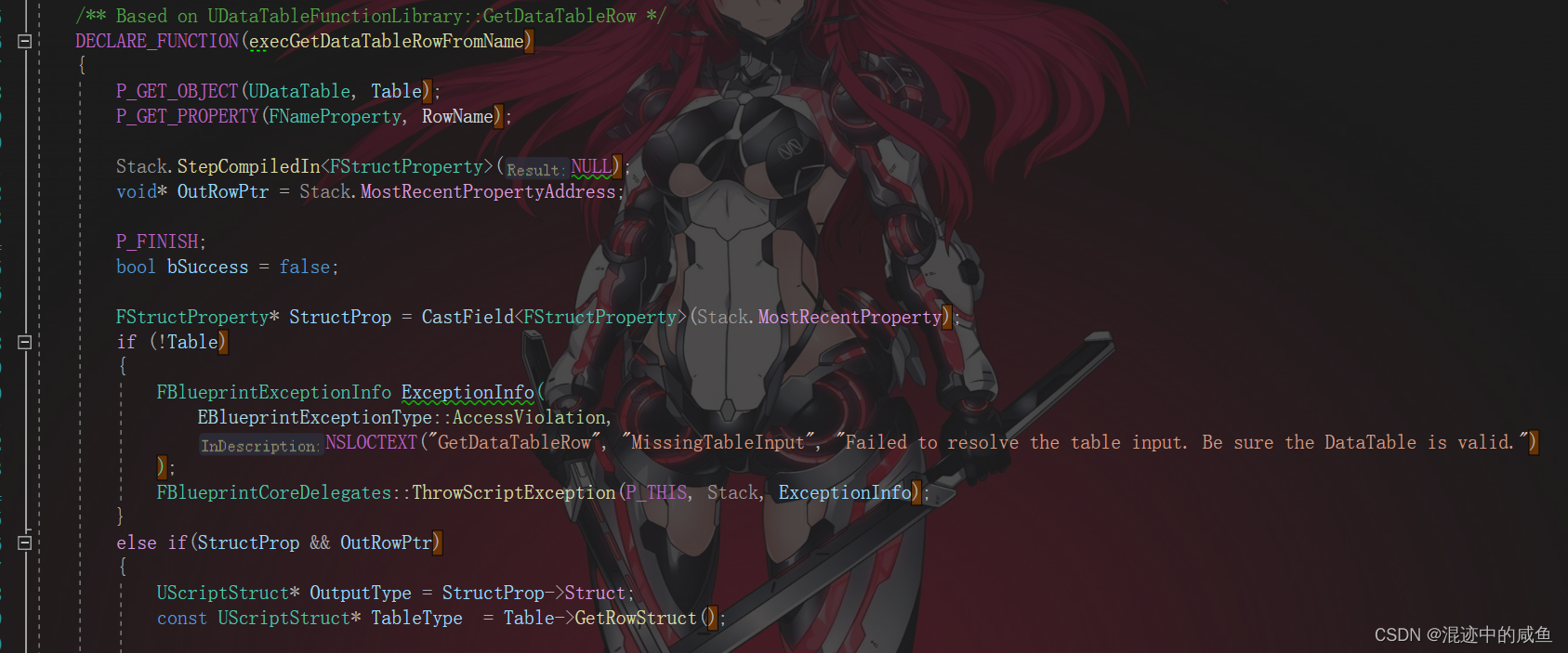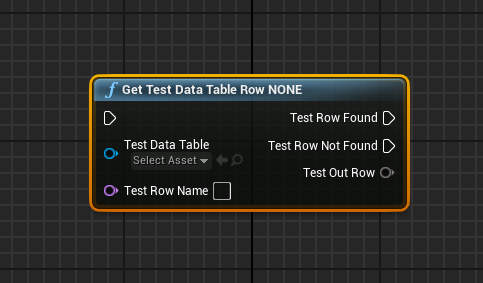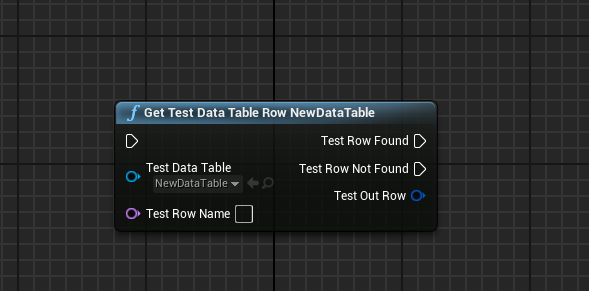UE4C++泛型蓝图节点之K2Node蓝图节点
- 前言:
上篇我们讲解了以CustomThunk方式创建自定义泛型节点,今天在此我们讲解以K2Node实现自定义蓝图节点。
首先,我们来比较这俩种方法,CustomThunk创建泛型节点时,代码简洁,调试起来也方便但是灵活度没有K2Node高,K2Node可以动态的改变的节点数量, 是更灵活的动态类型。就如K2Node可以用来创建下拉列表,比如UE源码中UK2Node_GetDataTableRow就是很经典的以K2Node开发的。我们可以看到它这个节点输入的时候是以下拉列表形式,可以选择不同的Datatable表,并输出不同类型的数据结构,这就是K2Node的比较灵活的地方,在更加灵活的开发上,就可以选择以K2Node的方式进行开发。K2Node的存在是用来优化蓝图到C++的远程调用方式(RPC)。

K2Node本质上与CustomThunk类型一致,都是以DECLARE_FUNCTION函数的类型进行的,只不过K2Node所对应的DECLARE_FUNCTION比较难找而已。继续拿UK2Node_GetDataTableRow举例,他的DECLARE_FUNCTION函数在UDataTableFunctionLibrary的蓝图函数库里面。

在遇到增加删除pin的时候,也会选择以K2Node进行开发实现,例如逻辑操作And节点就能动态的添加删除pin,而此刻用CustomThunk的Thunk函数体实现形式就完全不行,因此,在此我给大家分享一下K2Node的一些功能实现。

创建一个类继承自UK2Node

//鼠标放到上面的说明/注释
virtual FText GetTooltipText()const override;
//节点名称
virtual FText GetNodeTitle(ENodeTitleType::Type TitleType)const override;
//将节点添加到蓝图视图
virtual void GetMenuActions(FBlueprintActionDatabaseRegistrar& ActionRegister)const override;
//蓝图节点的标签
virtual FText GetMenuCategory()const;
//展开节点
virtual void ExpandNode(FKismetCompilerContext& CompilerContext, UEdGraph* SourceGraph)override;
//分配默认引脚
virtual void AllocateDefaultPins()override;
//引脚更改时会调用
virtual void PinDefaultValueChanged(UEdGraphPin* ChangedPin)override;
//连接情况更改以后
virtual void NotifyPinConnectionListChanged(UEdGraphPin* Pin)override;
//创建一个可视小部件来在图形编辑器或图形面板中表示这个节点。如果没有实现,则将使用默认的节点工厂
virtual TSharedPtr<SGraphNode> CreateVisualWidget() { return TSharedPtr<SGraphNode>(); }
// 为表示此节点的小部件创建背景图像
virtual TSharedPtr<SWidget> CreateNodeImage() const { return TSharedPtr<SWidget>(); }
//右键菜单, 比如添加RemovePin
virtual void GetNodeContextMenuActions(class UToolMenu* Menu, class UGraphNodeContextMenuContext* Context) const override;
知道这些了,我们再将UK2Node_GetDataTableRow中的代码全拷贝到自己的代码中,例如:
- .h
// Fill out your copyright notice in the Description page of Project Settings.
#pragma once
#include "CoreMinimal.h"
#include "K2Node.h"
#include "KismetCompiler.h"
#include "CoreMinimal.h"
#include "UObject/ObjectMacros.h"
#include "Textures/SlateIcon.h"
#include "EdGraph/EdGraphNodeUtils.h"
#include "Test_K2Node.generated.h"
/**
*
*/
class FBlueprintActionDatabaseRegistrar;
class UDataTable;
class UEdGraph;
UCLASS()
class GAME_SANDBOX_API UTest_K2Node : public UK2Node
{
GENERATED_BODY()
public:
/*
//鼠标放到上面的说明/注释
virtual FText GetTooltipText()const override;
//节点名称
virtual FText GetNodeTitle(ENodeTitleType::Type TitleType)const override;
//将节点添加到蓝图视图
virtual void GetMenuActions(FBlueprintActionDatabaseRegistrar& ActionRegister)const override;
//蓝图节点的标签
virtual FText GetMenuCategory()const;
//展开节点
virtual void ExpandNode(FKismetCompilerContext& CompilerContext, UEdGraph* SourceGraph)override;
//分配默认引脚
virtual void AllocateDefaultPins()override;
//引脚更改时会调用
virtual void PinDefaultValueChanged(UEdGraphPin* ChangedPin)override;
//连接情况更改以后
virtual void NotifyPinConnectionListChanged(UEdGraphPin* Pin)override;
//创建一个可视小部件来在图形编辑器或图形面板中表示这个节点。如果没有实现,则将使用默认的节点工厂
virtual TSharedPtr<SGraphNode> CreateVisualWidget() { return TSharedPtr<SGraphNode>(); }
// 为表示此节点的小部件创建背景图像
virtual TSharedPtr<SWidget> CreateNodeImage() const { return TSharedPtr<SWidget>(); }
//右键菜单, 比如添加RemovePin
virtual void GetNodeContextMenuActions(class UToolMenu* Menu, class UGraphNodeContextMenuContext* Context) const override;
*/
UTest_K2Node(const FObjectInitializer& ObjectInitializer);
//~ Begin UEdGraphNode Interface.
//分配默认引脚
virtual void AllocateDefaultPins() override;
//节点名称
virtual FText GetNodeTitle(ENodeTitleType::Type TitleType) const override;
//引脚更改时会调用
virtual void PinDefaultValueChanged(UEdGraphPin* Pin) override;
//鼠标放到上面的说明/注释
virtual FText GetTooltipText() const override;
//展开节点
virtual void ExpandNode(class FKismetCompilerContext& CompilerContext, UEdGraph* SourceGraph) override;
virtual FSlateIcon GetIconAndTint(FLinearColor& OutColor) const override;
virtual void PostReconstructNode() override;
//~ End UEdGraphNode Interface.
//~ Begin UK2Node Interface
virtual bool IsNodeSafeToIgnore() const override { return true; }
virtual void ReallocatePinsDuringReconstruction(TArray<UEdGraphPin*>& OldPins) override;
//将节点添加到蓝图视图
virtual void GetMenuActions(FBlueprintActionDatabaseRegistrar& ActionRegistrar) const override;
//蓝图节点的标签
virtual FText GetMenuCategory() const override;
virtual bool IsConnectionDisallowed(const UEdGraphPin* MyPin, const UEdGraphPin* OtherPin, FString& OutReason) const override;
virtual void EarlyValidation(class FCompilerResultsLog& MessageLog) const override;
virtual void PreloadRequiredAssets() override;
//连接情况更改以后
virtual void NotifyPinConnectionListChanged(UEdGraphPin* Pin) override;
//~ End UK2Node Interface
/** Get the return type of our struct */
UScriptStruct* GetReturnTypeForStruct();
/** Get the then output pin */
UEdGraphPin* GetThenPin() const;
/** Get the Data Table input pin */
UEdGraphPin* GetDataTablePin(const TArray<UEdGraphPin*>* InPinsToSearch = NULL) const;
/** Get the spawn transform input pin */
UEdGraphPin* GetRowNamePin() const;
/** Get the exec output pin for when the row was not found */
UEdGraphPin* GetRowNotFoundPin() const;
/** Get the result output pin */
UEdGraphPin* GetResultPin() const;
/** Get the type of the TableRow to return */
UScriptStruct* GetDataTableRowStructType() const;
void OnDataTableRowListChanged(const UDataTable* DataTable);
private:
/**
* Takes the specified "MutatablePin" and sets its 'PinToolTip' field (according
* to the specified description)
*
* @param MutatablePin The pin you want to set tool-tip text on
* @param PinDescription A string describing the pin's purpose
*/
void SetPinToolTip(UEdGraphPin& MutatablePin, const FText& PinDescription) const;
/** Set the return type of our struct */
void SetReturnTypeForStruct(UScriptStruct* InClass);
/** Queries for the authoritative return type, then modifies the return pin to match */
void RefreshOutputPinType();
/** Triggers a refresh which will update the node's widget; aimed at updating the dropdown menu for the RowName input */
void RefreshRowNameOptions();
// 此节点的Tooltip text
FText NodeTooltip;
// 构造FText字符串的开销很大,所以我们缓存节点的标题
FNodeTextCache CachedNodeTitle;
};
- .cpp
// Fill out your copyright notice in the Description page of Project Settings.
#include "Test_K2Node.h"
#include "Engine/DataTable.h"
#include "EdGraphSchema_K2.h"
#include "K2Node_CallFunction.h"
#include "K2Node_IfThenElse.h"
#include "Kismet2/BlueprintEditorUtils.h"
#include "KismetCompiler.h"
#include "DataTableEditorUtils.h"
#include "Kismet/DataTableFunctionLibrary.h"
#include "BlueprintNodeSpawner.h"
#include "EditorCategoryUtils.h"
#include "BlueprintActionDatabaseRegistrar.h"
#define LOCTEXT_NAMESPACE "K2Node_TestGetDataTableRow"
namespace GetTestDataTableRowHelper
{
const FName DataTablePinName = "TestDataTable";
const FName RowNotFoundPinName = "TestRowNotFound";
const FName RowNamePinName = "TestRowName";
}
UTest_K2Node::UTest_K2Node(const FObjectInitializer& ObjectInitializer)
: Super(ObjectInitializer)
{
NodeTooltip = LOCTEXT("NodeTooltip", "Attempts to retrieve a Test TableRow from a DataTable via it's RowName");
}
void UTest_K2Node::AllocateDefaultPins()
{
const UEdGraphSchema_K2* K2Schema = GetDefault<UEdGraphSchema_K2>();
// Add execution pins
CreatePin(EGPD_Input, UEdGraphSchema_K2::PC_Exec, UEdGraphSchema_K2::PN_Execute);
UEdGraphPin* RowFoundPin = CreatePin(EGPD_Output, UEdGraphSchema_K2::PC_Exec, UEdGraphSchema_K2::PN_Then);
RowFoundPin->PinFriendlyName = LOCTEXT("GetDataTableRow Row Found Exec pin", "Test Row Found");
CreatePin(EGPD_Output, UEdGraphSchema_K2::PC_Exec, GetTestDataTableRowHelper::RowNotFoundPinName);
// Add DataTable pin
UEdGraphPin* DataTablePin = CreatePin(EGPD_Input, UEdGraphSchema_K2::PC_Object, UDataTable::StaticClass(), GetTestDataTableRowHelper::DataTablePinName);
SetPinToolTip(*DataTablePin, LOCTEXT("DataTablePinDescription", "Test The DataTable you want to retreive a row from"));
// Row Name pin
UEdGraphPin* RowNamePin = CreatePin(EGPD_Input, UEdGraphSchema_K2::PC_Name, GetTestDataTableRowHelper::RowNamePinName);
SetPinToolTip(*RowNamePin, LOCTEXT("RowNamePinDescription", "Test The name of the row to retrieve from the DataTable"));
// Result pin
UEdGraphPin* ResultPin = CreatePin(EGPD_Output, UEdGraphSchema_K2::PC_Wildcard, UEdGraphSchema_K2::PN_ReturnValue);
ResultPin->PinFriendlyName = LOCTEXT("GetDataTableRow Output Row", "Test Out Row");
SetPinToolTip(*ResultPin, LOCTEXT("ResultPinDescription", "Test The returned TableRow, if found"));
Super::AllocateDefaultPins();
}
void UTest_K2Node::SetPinToolTip(UEdGraphPin& MutatablePin, const FText& PinDescription) const
{
MutatablePin.PinToolTip = UEdGraphSchema_K2::TypeToText(MutatablePin.PinType).ToString();
UEdGraphSchema_K2 const* const K2Schema = Cast<const UEdGraphSchema_K2>(GetSchema());
if (K2Schema != nullptr)
{
MutatablePin.PinToolTip += TEXT(" ");
MutatablePin.PinToolTip += K2Schema->GetPinDisplayName(&MutatablePin).ToString();
}
MutatablePin.PinToolTip += FString(TEXT("\n")) + PinDescription.ToString();
}
void UTest_K2Node::RefreshOutputPinType()
{
UScriptStruct* OutputType = GetDataTableRowStructType();
SetReturnTypeForStruct(OutputType);
}
void UTest_K2Node::RefreshRowNameOptions()
{
// When the DataTable pin gets a new value assigned, we need to update the Slate UI so that SGraphNodeCallParameterCollectionFunction will update the ParameterName drop down
UEdGraph* Graph = GetGraph();
Graph->NotifyGraphChanged();
}
void UTest_K2Node::SetReturnTypeForStruct(UScriptStruct* NewRowStruct)
{
UScriptStruct* OldRowStruct = GetReturnTypeForStruct();
if (NewRowStruct != OldRowStruct)
{
UEdGraphPin* ResultPin = GetResultPin();
if (ResultPin->SubPins.Num() > 0)
{
GetSchema()->RecombinePin(ResultPin);
}
// NOTE: purposefully not disconnecting the ResultPin (even though it changed type)... we want the user to see the old
// connections, and incompatible connections will produce an error (plus, some super-struct connections may still be valid)
ResultPin->PinType.PinSubCategoryObject = NewRowStruct;
ResultPin->PinType.PinCategory = (NewRowStruct == nullptr) ? UEdGraphSchema_K2::PC_Wildcard : UEdGraphSchema_K2::PC_Struct;
CachedNodeTitle.Clear();
}
}
UScriptStruct* UTest_K2Node::GetReturnTypeForStruct()
{
UScriptStruct* ReturnStructType = (UScriptStruct*)(GetResultPin()->PinType.PinSubCategoryObject.Get());
return ReturnStructType;
}
UScriptStruct* UTest_K2Node::GetDataTableRowStructType() const
{
UScriptStruct* RowStructType = nullptr;
UEdGraphPin* DataTablePin = GetDataTablePin();
if(DataTablePin && DataTablePin->DefaultObject != nullptr && DataTablePin->LinkedTo.Num() == 0)
{
if (const UDataTable* DataTable = Cast<const UDataTable>(DataTablePin->DefaultObject))
{
RowStructType = DataTable->RowStruct;
}
}
if (RowStructType == nullptr)
{
UEdGraphPin* ResultPin = GetResultPin();
if (ResultPin && ResultPin->LinkedTo.Num() > 0)
{
RowStructType = Cast<UScriptStruct>(ResultPin->LinkedTo[0]->PinType.PinSubCategoryObject.Get());
for (int32 LinkIndex = 1; LinkIndex < ResultPin->LinkedTo.Num(); ++LinkIndex)
{
UEdGraphPin* Link = ResultPin->LinkedTo[LinkIndex];
UScriptStruct* LinkType = Cast<UScriptStruct>(Link->PinType.PinSubCategoryObject.Get());
if (RowStructType->IsChildOf(LinkType))
{
RowStructType = LinkType;
}
}
}
}
return RowStructType;
}
void UTest_K2Node::OnDataTableRowListChanged(const UDataTable* DataTable)
{
UEdGraphPin* DataTablePin = GetDataTablePin();
if (DataTable && DataTablePin && DataTable == DataTablePin->DefaultObject)
{
UEdGraphPin* RowNamePin = GetRowNamePin();
const bool TryRefresh = RowNamePin && !RowNamePin->LinkedTo.Num();
const FName CurrentName = RowNamePin ? FName(*RowNamePin->GetDefaultAsString()) : NAME_None;
if (TryRefresh && RowNamePin && !DataTable->GetRowNames().Contains(CurrentName))
{
if (UBlueprint* BP = GetBlueprint())
{
FBlueprintEditorUtils::MarkBlueprintAsModified(BP);
}
}
}
}
void UTest_K2Node::ReallocatePinsDuringReconstruction(TArray<UEdGraphPin*>& OldPins)
{
Super::ReallocatePinsDuringReconstruction(OldPins);
if (UEdGraphPin* DataTablePin = GetDataTablePin(&OldPins))
{
if (UDataTable* DataTable = Cast<UDataTable>(DataTablePin->DefaultObject))
{
// make sure to properly load the data-table object so that we can
// farm the "RowStruct" property from it (below, in GetDataTableRowStructType)
PreloadObject(DataTable);
}
}
}
void UTest_K2Node::GetMenuActions(FBlueprintActionDatabaseRegistrar& ActionRegistrar) const
{
// actions get registered under specific object-keys; the idea is that
// actions might have to be updated (or deleted) if their object-key is
// mutated (or removed)... here we use the node's class (so if the node
// type disappears, then the action should go with it)
UClass* ActionKey = GetClass();
// to keep from needlessly instantiating a UBlueprintNodeSpawner, first
// check to make sure that the registrar is looking for actions of this type
// (could be regenerating actions for a specific asset, and therefore the
// registrar would only accept actions corresponding to that asset)
if (ActionRegistrar.IsOpenForRegistration(ActionKey))
{
UBlueprintNodeSpawner* NodeSpawner = UBlueprintNodeSpawner::Create(GetClass());
check(NodeSpawner != nullptr);
ActionRegistrar.AddBlueprintAction(ActionKey, NodeSpawner);
}
}
FText UTest_K2Node::GetMenuCategory() const
{
return FEditorCategoryUtils::GetCommonCategory(FCommonEditorCategory::Utilities);
}
bool UTest_K2Node::IsConnectionDisallowed(const UEdGraphPin* MyPin, const UEdGraphPin* OtherPin, FString& OutReason) const
{
if (MyPin == GetResultPin() && MyPin->PinType.PinCategory == UEdGraphSchema_K2::PC_Wildcard)
{
bool bDisallowed = true;
if (OtherPin->PinType.PinCategory == UEdGraphSchema_K2::PC_Struct)
{
if (UScriptStruct* ConnectionType = Cast<UScriptStruct>(OtherPin->PinType.PinSubCategoryObject.Get()))
{
bDisallowed = !FDataTableEditorUtils::IsValidTableStruct(ConnectionType);
}
}
else if (OtherPin->PinType.PinCategory == UEdGraphSchema_K2::PC_Wildcard)
{
bDisallowed = false;
}
if (bDisallowed)
{
OutReason = TEXT("Must be a struct that can be used in a DataTable");
}
return bDisallowed;
}
return false;
}
void UTest_K2Node::PinDefaultValueChanged(UEdGraphPin* ChangedPin)
{
if (ChangedPin && ChangedPin->PinName == GetTestDataTableRowHelper::DataTablePinName)
{
RefreshOutputPinType();
UEdGraphPin* RowNamePin = GetRowNamePin();
UDataTable* DataTable = Cast<UDataTable>(ChangedPin->DefaultObject);
if (RowNamePin)
{
if (DataTable && (RowNamePin->DefaultValue.IsEmpty() || !DataTable->GetRowMap().Contains(*RowNamePin->DefaultValue)))
{
if (auto Iterator = DataTable->GetRowMap().CreateConstIterator())
{
RowNamePin->DefaultValue = Iterator.Key().ToString();
}
}
RefreshRowNameOptions();
}
}
}
FText UTest_K2Node::GetTooltipText() const
{
return NodeTooltip;
}
UEdGraphPin* UTest_K2Node::GetThenPin()const
{
const UEdGraphSchema_K2* K2Schema = GetDefault<UEdGraphSchema_K2>();
UEdGraphPin* Pin = FindPinChecked(UEdGraphSchema_K2::PN_Then);
check(Pin->Direction == EGPD_Output);
return Pin;
}
UEdGraphPin* UTest_K2Node::GetDataTablePin(const TArray<UEdGraphPin*>* InPinsToSearch /*= NULL*/) const
{
const TArray<UEdGraphPin*>* PinsToSearch = InPinsToSearch ? InPinsToSearch : &Pins;
UEdGraphPin* Pin = nullptr;
for (UEdGraphPin* TestPin : *PinsToSearch)
{
if (TestPin && TestPin->PinName == GetTestDataTableRowHelper::DataTablePinName)
{
Pin = TestPin;
break;
}
}
check(Pin == nullptr || Pin->Direction == EGPD_Input);
return Pin;
}
UEdGraphPin* UTest_K2Node::GetRowNamePin() const
{
UEdGraphPin* Pin = FindPinChecked(GetTestDataTableRowHelper::RowNamePinName);
check(Pin->Direction == EGPD_Input);
return Pin;
}
UEdGraphPin* UTest_K2Node::GetRowNotFoundPin() const
{
UEdGraphPin* Pin = FindPinChecked(GetTestDataTableRowHelper::RowNotFoundPinName);
check(Pin->Direction == EGPD_Output);
return Pin;
}
UEdGraphPin* UTest_K2Node::GetResultPin() const
{
const UEdGraphSchema_K2* K2Schema = GetDefault<UEdGraphSchema_K2>();
UEdGraphPin* Pin = FindPinChecked(UEdGraphSchema_K2::PN_ReturnValue);
check(Pin->Direction == EGPD_Output);
return Pin;
}
FText UTest_K2Node::GetNodeTitle(ENodeTitleType::Type TitleType) const
{
if (TitleType == ENodeTitleType::MenuTitle)
{
return LOCTEXT("ListViewTitle", "Get Data Table Row");
}
else if (UEdGraphPin* DataTablePin = GetDataTablePin())
{
if (DataTablePin->LinkedTo.Num() > 0)
{
return NSLOCTEXT("TestK2Node", "DataTable_Title_Unknown", "Get Test Data Table Row");
}
else if (DataTablePin->DefaultObject == nullptr)
{
return NSLOCTEXT("TestK2Node", "DataTable_Title_None", "Get Test Data Table Row NONE");
}
else if (CachedNodeTitle.IsOutOfDate(this))
{
FFormatNamedArguments Args;
Args.Add(TEXT("DataTableName"), FText::FromString(DataTablePin->DefaultObject->GetName()));
FText LocFormat = NSLOCTEXT("TestK2Node", "DataTable", "Get Test Data Table Row {DataTableName}");
// FText::Format() is slow, so we cache this to save on performance
CachedNodeTitle.SetCachedText(FText::Format(LocFormat, Args), this);
}
}
else
{
return NSLOCTEXT("TestK2Node", "DataTable_Title_None", "Get Test Data Table Row NONE");
}
return CachedNodeTitle;
}
void UTest_K2Node::ExpandNode(class FKismetCompilerContext& CompilerContext, UEdGraph* SourceGraph)
{
Super::ExpandNode(CompilerContext, SourceGraph);
UEdGraphPin* OriginalDataTableInPin = GetDataTablePin();
UDataTable* Table = (OriginalDataTableInPin != NULL) ? Cast<UDataTable>(OriginalDataTableInPin->DefaultObject) : NULL;
if((nullptr == OriginalDataTableInPin) || (0 == OriginalDataTableInPin->LinkedTo.Num() && nullptr == Table))
{
CompilerContext.MessageLog.Error(*LOCTEXT("GetDataTableRowNoDataTable_Error", "GetTestDataTableRow must have a DataTable specified.").ToString(), this);
// we break exec links so this is the only error we get
BreakAllNodeLinks();
return;
}
// FUNCTION NODE
const FName FunctionName = GET_FUNCTION_NAME_CHECKED(UDataTableFunctionLibrary, GetDataTableRowFromName);
UK2Node_CallFunction* GetDataTableRowFunction = CompilerContext.SpawnIntermediateNode<UK2Node_CallFunction>(this, SourceGraph);
GetDataTableRowFunction->FunctionReference.SetExternalMember(FunctionName, UDataTableFunctionLibrary::StaticClass());
GetDataTableRowFunction->AllocateDefaultPins();
CompilerContext.MovePinLinksToIntermediate(*GetExecPin(), *(GetDataTableRowFunction->GetExecPin()));
// Connect the input of our GetDataTableRow to the Input of our Function pin
UEdGraphPin* DataTableInPin = GetDataTableRowFunction->FindPinChecked(TEXT("Table"));
if(OriginalDataTableInPin->LinkedTo.Num() > 0)
{
// Copy the connection
CompilerContext.MovePinLinksToIntermediate(*OriginalDataTableInPin, *DataTableInPin);
}
else
{
// Copy literal
DataTableInPin->DefaultObject = OriginalDataTableInPin->DefaultObject;
}
UEdGraphPin* RowNameInPin = GetDataTableRowFunction->FindPinChecked(TEXT("RowName"));
CompilerContext.MovePinLinksToIntermediate(*GetRowNamePin(), *RowNameInPin);
// Get some pins to work with
UEdGraphPin* OriginalOutRowPin = FindPinChecked(UEdGraphSchema_K2::PN_ReturnValue);
UEdGraphPin* FunctionOutRowPin = GetDataTableRowFunction->FindPinChecked(TEXT("OutRow"));
UEdGraphPin* FunctionReturnPin = GetDataTableRowFunction->FindPinChecked(UEdGraphSchema_K2::PN_ReturnValue);
UEdGraphPin* FunctionThenPin = GetDataTableRowFunction->GetThenPin();
// Set the type of the OutRow pin on this expanded mode to match original
FunctionOutRowPin->PinType = OriginalOutRowPin->PinType;
FunctionOutRowPin->PinType.PinSubCategoryObject = OriginalOutRowPin->PinType.PinSubCategoryObject;
//BRANCH NODE
UK2Node_IfThenElse* BranchNode = CompilerContext.SpawnIntermediateNode<UK2Node_IfThenElse>(this, SourceGraph);
BranchNode->AllocateDefaultPins();
// Hook up inputs to branch
FunctionThenPin->MakeLinkTo(BranchNode->GetExecPin());
FunctionReturnPin->MakeLinkTo(BranchNode->GetConditionPin());
// Hook up outputs
CompilerContext.MovePinLinksToIntermediate(*GetThenPin(), *(BranchNode->GetThenPin()));
CompilerContext.MovePinLinksToIntermediate(*GetRowNotFoundPin(), *(BranchNode->GetElsePin()));
CompilerContext.MovePinLinksToIntermediate(*OriginalOutRowPin, *FunctionOutRowPin);
BreakAllNodeLinks();
}
FSlateIcon UTest_K2Node::GetIconAndTint(FLinearColor& OutColor) const
{
OutColor = GetNodeTitleColor();
static FSlateIcon Icon("EditorStyle", "Kismet.AllClasses.FunctionIcon");
return Icon;
}
void UTest_K2Node::PostReconstructNode()
{
Super::PostReconstructNode();
RefreshOutputPinType();
}
void UTest_K2Node::EarlyValidation(class FCompilerResultsLog& MessageLog) const
{
Super::EarlyValidation(MessageLog);
const UEdGraphPin* DataTablePin = GetDataTablePin();
const UEdGraphPin* RowNamePin = GetRowNamePin();
if (!DataTablePin || !RowNamePin)
{
MessageLog.Error(*LOCTEXT("MissingPins", "Missing pins in @@").ToString(), this);
return;
}
if (DataTablePin->LinkedTo.Num() == 0)
{
const UDataTable* DataTable = Cast<UDataTable>(DataTablePin->DefaultObject);
if (!DataTable)
{
MessageLog.Error(*LOCTEXT("NoDataTable", "No DataTable in @@").ToString(), this);
return;
}
if (!RowNamePin->LinkedTo.Num())
{
const FName CurrentName = FName(*RowNamePin->GetDefaultAsString());
if (!DataTable->GetRowNames().Contains(CurrentName))
{
const FString Msg = FText::Format(
LOCTEXT("WrongRowNameFmt", "'{0}' row name is not stored in '{1}'. @@"),
FText::FromString(CurrentName.ToString()),
FText::FromString(GetFullNameSafe(DataTable))
).ToString();
MessageLog.Error(*Msg, this);
return;
}
}
}
}
void UTest_K2Node::PreloadRequiredAssets()
{
if (UEdGraphPin* DataTablePin = GetDataTablePin())
{
if (UDataTable* DataTable = Cast<UDataTable>(DataTablePin->DefaultObject))
{
// make sure to properly load the data-table object so that we can
// farm the "RowStruct" property from it (below, in GetDataTableRowStructType)
PreloadObject(DataTable);
}
}
return Super::PreloadRequiredAssets();
}
void UTest_K2Node::NotifyPinConnectionListChanged(UEdGraphPin* Pin)
{
Super::NotifyPinConnectionListChanged(Pin);
if (Pin == GetResultPin())
{
UEdGraphPin* TablePin = GetDataTablePin();
// this connection would only change the output type if the table pin is undefined
const bool bIsTypeAuthority = (TablePin->LinkedTo.Num() > 0 || TablePin->DefaultObject == nullptr);
if (bIsTypeAuthority)
{
RefreshOutputPinType();
}
}
else if (Pin == GetDataTablePin())
{
const bool bConnectionAdded = Pin->LinkedTo.Num() > 0;
if (bConnectionAdded)
{
// if a connection was made, then we may need to rid ourselves of the row dropdown
RefreshRowNameOptions();
// if the output connection was previously, incompatible, it now becomes the authority on this node's output type
RefreshOutputPinType();
}
}
}
#undef LOCTEXT_NAMESPACE
如果代码改的发现还有错误,这时候添加模块,此处我选择偷懒,是将UK2Node_GetDataTableRow所在的模块添加进入.build.cs文件中,在将其中的private中的文件拷贝到.build.cs中,因为,私有模块在添加之后,其他模块是无法使用的。我之前的模块添加应该有讲到,感兴趣的可以稍微看看。

以下便是添加好的模块
PublicDependencyModuleNames.AddRange(new string[] { "Core", "CoreUObject", "Engine", "InputCore", "BlueprintGraph" });
PrivateDependencyModuleNames.AddRange(
new string[]
{
"Slate",
"SlateCore",
"ApplicationCore",
"EditorStyle",
"KismetCompiler",
"UnrealEd",
"GraphEditor",
"Kismet",
"KismetWidgets",
"PropertyEditor",
"ToolMenus",
});
运行之后选择Datatable和不选择Datatable便是这俩种情况


这时候我们再深入研究代码即可
- 创建输入引脚
CreatePin(EGPD_Input, UEdGraphSchema_K2::PC_Exec, UEdGraphSchema_K2::PN_Execute);
- 创建输出引脚
CreatePin(EGPD_Output, UEdGraphSchema_K2::PC_Exec, UEdGraphSchema_K2::PN_Then);
数组类型的输出引脚
// Create the output pin
UEdGraphNode::FCreatePinParams PinParams;
PinParams.ContainerType = EPinContainerType::Array;
PinParams.bIsReference = false;
CreatePin(EGPD_Output, UEdGraphSchema_K2::PC_Byte, UEdGraphSchema_K2::PN_ReturnValue, PinParams);
继承 IK2Node_AddPinInterface接口后重写virtual void AddInputPin() override函数添加Pin
void UK2Node_ConvertScriptCallValue::AddInputPin()
{
CreatePin(EGPD_Input, UEdGraphSchema_K2::PC_Wildcard, GetPinName(NumInputs));
NumInputs++;
}
添加移除Pin的操作
void UK2Node_ConvertScriptCallValue::GetNodeContextMenuActions(UToolMenu* Menu, UGraphNodeContextMenuContext* Context) const
{
Super::GetNodeContextMenuActions(Menu, Context);
if (!Context->bIsDebugging)
{
static FName CommutativeAssociativeBinaryOperatorNodeName = FName("K2Node_ConvertScriptCallValue");
FText CommutativeAssociativeBinaryOperatorStr = LOCTEXT("K2Node_ConvertScriptCallValue", "Operator Node");
if (Context->Pin != NULL)
{
if (CanRemovePin(Context->Pin))
{
FToolMenuSection& Section =
Menu->AddSection(CommutativeAssociativeBinaryOperatorNodeName, CommutativeAssociativeBinaryOperatorStr);
Section.AddMenuEntry("RemovePin", LOCTEXT("RemovePin", "Remove pin"),
LOCTEXT("RemovePinTooltip", "Remove this input pin"), FSlateIcon(),
FUIAction(FExecuteAction::CreateUObject(const_cast<UK2Node_ConvertScriptCallValue*>(this),
&UK2Node_ConvertScriptCallValue::RemoveInputPin, const_cast<UEdGraphPin*>(Context->Pin))));
}
}
}
}
移除pin
void UK2Node_ConvertScriptCallValue::RemoveInputPin(UEdGraphPin * Pin)
{
FScopedTransaction Transaction(FText::FromString("ConvertScriptCallValue_RemoveInputPin"));
Modify();
--NumInputs;
RemovePin(Pin);
SyncPinNames();
FBlueprintEditorUtils::MarkBlueprintAsStructurallyModified(GetBlueprint());
}
次篇幅就到此为止,下章讲解详细的使用,大家喜欢就点个赞吧!






















 4058
4058











 被折叠的 条评论
为什么被折叠?
被折叠的 条评论
为什么被折叠?








